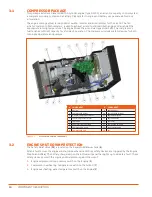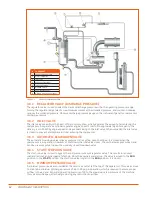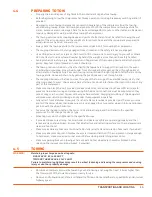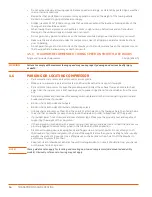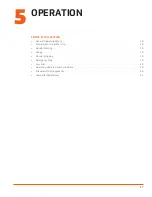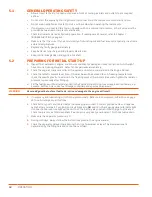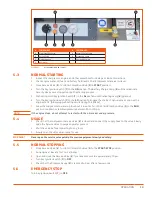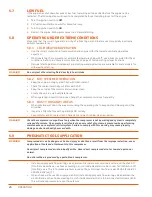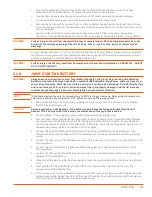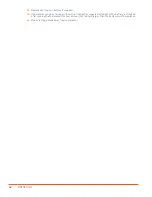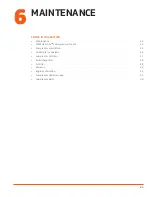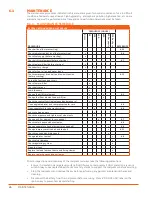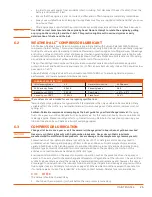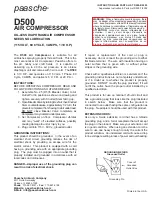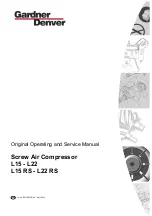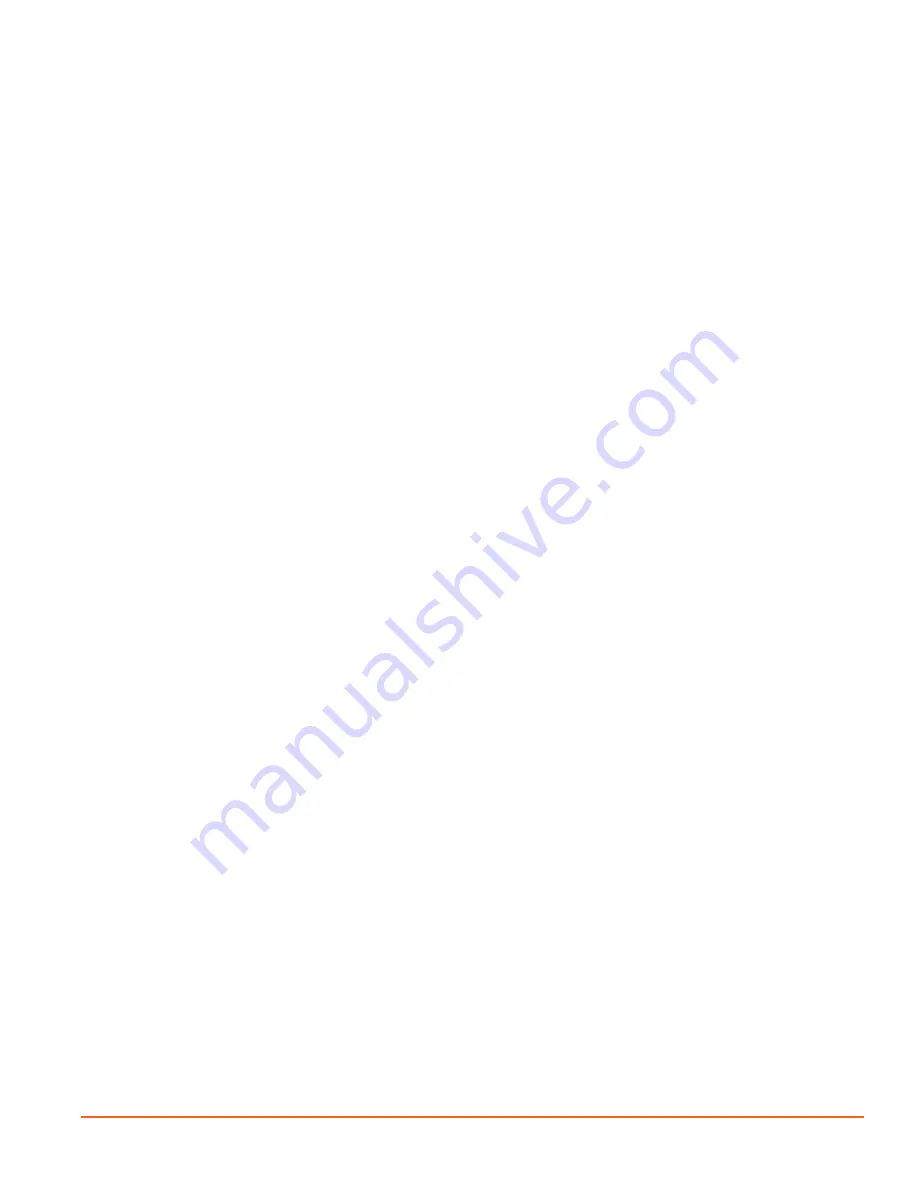
11
COMPONENT DESCRIPTION
3.3
COMPRESSOR COOLING
The compressor cooling and lubrication system is designed to provide adequate lubrication as well as
maintain the proper operating temperature of the compressor.
The Fan (
16
) vents the heat coming from the compression of the air with the oil, which flows through the
Cooler (
4
) and cooled due to the air issued from the Fan. (
16
)
When operating, the compressor fluid circulates from the Separator (
6
) to the Cooler (
4
). This circulation is
caused by the pressure difference between the Separator (
6
) high pressure and the low pressure zone of the
Air End (
7
) compressor unit. The fluid is then returned to the main Oil Filter (
2
) where it is filtered prior to
re-injection into the compression chamber and bearings of the compressor unit.
3.4
SEPARATOR
The separator has four main functions:
1.
Primary fluid separation system
2.
Final fluid separation system
3.
Fluid tank
4.
Air reserve for the regulation
The compressed air/fluid mixture is then pushed into the separator, where it flows through the separator
body. This change of direction slows down the air speed and creates larger droplets of fluid which fall to the
bottom of the sump. The remaining oil contained in the air is separated in the separator cartridge and via
gravity travels down to the sump where it is pushed by pressure difference in the dip tube that leads back to
the air end suction. The separator is EC certified.
A calibrated port, located downstream from the separator, helps maintain a minimum receiver pressure of 51
psig (3.5 bar) under all conditions. This pressure is necessary for proper air/fluid separation and proper fluid
circulation. A Pressure Relief Valve (
15
) located on the separator is set to open if the sump pressure exceeds
145 psig (10 bar).
3.5
COMPRESSOR FLUID
The compressor fluid (oil) has three main functions:
1.
As a coolant it controls the rise of air temperature associated with the heat of compression;
2.
It seals the leakage paths between the rotor and the stator, and also between the rotors themselves;
3.
It acts as a lubricating film between the rotors allowing one rotor to directly drive the other, which is an
idler.
3.6
CAPACITY CONTROL SYSTEM
The control system is designed to match air supply to air demand and to prevent excessive discharge
pressure when the compressor is operating but air is not being used. Control of air delivery is accomplished
both by inlet valve regulation and engine speed control as directed by the adjustable discharge pressure
regulator valve(s). The following information explains the operation of the control from a condition of “no
load” to a condition of “full capacity” at working pressure.
For the working pressure range of your machine, refer to applicable data in the specifications section. The
inlet valve cylinder pressure chamber is pneumatically connected to the dry side of the receiver via the
pressure regulator valve. When the separator pressure is below the set point of the regulator valve no
pressure will exist in the inlet valve cylinder. Under these conditions, the inlet valve will remain wide open,
causing the compressor to deliver full capacity. As the demand for air decreases, the receiver pressure
will rise, and when this pressure level exceeds the set point of the pressure regulator valve, control signal
pressure will be allowed to enter the inlet valve chamber which in turn will move the modulating piston and
the valve plate to a closed condition, thereby throttling the incoming air. A separate throttle air cylinder
controls engine speed.
The air cylinder is spring loaded in the full speed position when there is no air signal from the pressure
regulator valve. Whenever less than full capacity is required, receiver pressure increases, thereby opening
the pressure regulator, which allows a pressure signal to enter the throttle air cylinder and reduce the engine
speed until it matches the air requirements from 100% down to 60%. From 60% down to 0% both engine
speed reduction and inlet valve modulation act together to reduce air output.
Summary of Contents for D110PKU
Page 4: ......
Page 6: ...vi About This Manual ...
Page 13: ...5 2 SPECIFICATIONS TOPICS IN THIS SECTION Technical Data 6 Dimensions 7 ...
Page 16: ...8 Specifications ...
Page 44: ...36 Troubleshooting ...
Page 48: ...40 Parts Catalog 8 6 ENGINE ASSEMBLY ...
Page 50: ...42 Parts Catalog 8 7 ENGINE MOUNTING ASSEMBLY ...
Page 52: ...44 Parts Catalog 8 8 ENGINE TO FRAME ASSEMBLY ...
Page 54: ...46 Parts Catalog 8 9 BATTERY ASSEMBLY ...
Page 56: ...48 Parts Catalog 8 10 EXHAUST ASSEMBLY ...
Page 58: ...50 Parts Catalog 8 11 COMPRESSOR ASSEMBLY ...
Page 60: ...52 Parts Catalog 8 12 INLET VALVE ASSEMBLY ...
Page 62: ...54 Parts Catalog 8 13 AIR FILTER ASSEMBLY ...
Page 64: ...56 Parts Catalog 8 14 RECEIVER ASSEMBLY ...
Page 66: ...58 Parts Catalog 8 15 RECEIVER ASSEMBLY TO FRAME ...
Page 68: ...60 Parts Catalog 8 16 CONTROL TUBING ASSEMBLY ...
Page 70: ...62 Parts Catalog 8 17 COOLING ASSEMBLY ...
Page 72: ...64 Parts Catalog 8 18 COOLING ASSEMBLY ATTACHMENT TO FRAME ...
Page 74: ...66 Parts Catalog 8 19 COOLING SYSTEM HOSES AND RECOVERY TANK INSTALLATION ...
Page 76: ...68 Parts Catalog 8 20 OIL FILTER AND DISCHARGE HOSE ASSEMBLY ...
Page 78: ...70 Parts Catalog 8 21 FUEL TANK ASSEMBLY ...
Page 80: ...72 Parts Catalog 8 22 INSTRUMENT PANEL ASSEMBLY ...
Page 82: ...74 Parts Catalog 8 23 CANOPY ASSEMBLY ...
Page 84: ...76 Parts Catalog 8 24 CANOPY INSTALLATION ...
Page 86: ...78 Parts Catalog 8 25 LIFTING BAIL ASSEMBLY ...
Page 88: ...80 Parts Catalog 8 26 FRONT CROSSMEMBER ASSEMBLY ...
Page 90: ...82 Parts Catalog 8 27 LIGHT PACKAGE ...
Page 92: ...84 Parts Catalog 8 28 FENDER INSTALLATION ...
Page 94: ...86 Parts Catalog 8 29 AXLE AND WHEEL ASSEMBLY ...
Page 98: ...NOTES ...
Page 99: ...NOTES ...














